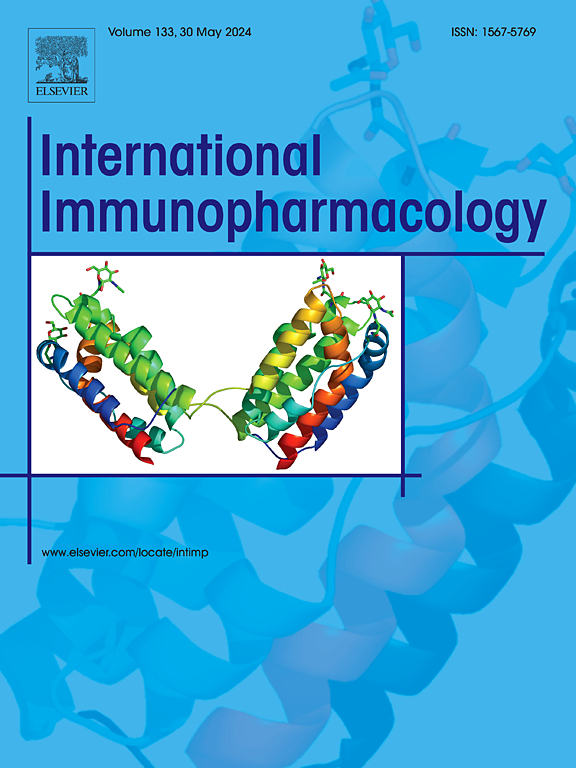基于动态炎症标志物预测晚期胃癌对pd -1治疗原发性耐药的Nomogram:一项多中心回顾性研究
IF 4.8
2区 医学
Q2 IMMUNOLOGY
引用次数: 0
摘要
虽然PD-1抑制剂改善了晚期胃癌(AGC)的临床结果,但原发性耐药仍然是一个重大的治疗挑战。尽管炎症标志物在免疫治疗中显示出预后潜力,但它们在预测PD-1抑制剂原发性耐药方面的作用仍未得到充分研究。我们开发并验证了一种基于炎症标志物的nomogram预测AGC患者对抗pd -1治疗的原发性耐药。方法本多中心回顾性研究纳入314例AGC患者,分为训练组(N = 191)、内部验证组(N = 82)和外部验证组(N = 41)。通过Wilcoxon sign -rank试验,在基线、两个疗程治疗后和初次耐药时评估炎症标志物的动态变化。进行多变量逻辑回归以确定原发耐药的独立预测因子,然后将其纳入nomogram。采用受试者工作特征(ROC)曲线、校正曲线和决策曲线分析(DCA)全面评估模型的性能。结果原发性耐药143例(45.5%)。在抗pd -1治疗后,获得完全/部分缓解的患者表现出中性粒细胞-淋巴细胞比率(NLR)、血小板-淋巴细胞比率(PLR)和全身免疫炎症指数(SII)水平的显著降低(P <;0.001)。相反,进展性疾病与NLR升高相关(P <;0.001), PLR (P <;0.010), SII (P <;0.001)和预后营养指数降低(PNI, P <;0.001)。在初次耐药时,NLR水平明显高于基线水平,PNI水平低于基线水平(所有P <;0.001)。此外,治疗线(P = 0.002)、HER-2阴性(P = 0.049)、高SII (P = 0.001)和2个疗程后低PNI (P = 0.001)是原发性耐药的独立预测因子。整合这些因素的nomogram(训练AUC: 0.767,内部/外部验证AUC: 0.756/0.729)对DCA的最佳校准和临床应用具有很强的辨别能力。结论:纵向炎症标志物分析可以动态监测抗pd -1治疗反应。基于炎症标志物建立的原发性耐药预测nomogram,为AGC患者接受抗pd -1治疗的风险分层和治疗决策提供了重要参考。本文章由计算机程序翻译,如有差异,请以英文原文为准。
Nomogram for predicting primary resistance to anti-PD-1 therapy in advanced gastric cancer based on dynamic inflammatory markers: a multicenter retrospective study
Background
While PD-1 inhibitors have improved clinical outcomes in advanced gastric cancer (AGC), primary resistance remains a significant therapeutic challenge. Although inflammatory markers have shown prognostic potential in immunotherapy, their role in predicting primary resistance to PD-1 inhibitors remains underexplored. We developed and validated an inflammatory marker-based nomogram for predicting primary resistance to anti-PD-1 therapy in AGC patients.
Methods
This multicenter retrospective study enrolled 314 AGC patients separated into training (N = 191), internal validation (N = 82), and external validation (N = 41) cohorts. Dynamic changes in inflammatory markers were assessed at baseline, after two courses of treatment, and at primary resistance via Wilcoxon signed-rank tests. Multivariate logistic regression was performed to identify independent predictors of primary resistance, which were then included in the nomogram. Receiver operating characteristic (ROC) curves, calibration curves, and decision curve analysis (DCA) were used to assess the model's performance thoroughly.
Results
Overall, primary resistance occurred in 143 patients (45.5 %). After anti-PD-1 therapy, patients who achieved a complete/partial response presented significant decreases in the neutrophil–lymphocyte ratio (NLR), platelet–lymphocyte ratio (PLR), and systemic immune–inflammatory index (SII) level (all P < 0.001). In contrast, progressive disease was associated with an elevated NLR (P < 0.001), PLR (P < 0.010), and SII (P < 0.001) and a reduced prognostic nutritional index (PNI, P < 0.001). At primary resistance onset, NLR levels were markedly greater and PNI levels were lower than those at baseline (all P < 0.001). Furthermore, treatment lines (P = 0.002), HER-2 negativity (P = 0.049), high SII (P = 0.001) and low PNI after 2 courses of treatment (P = 0.001) were independent predictors of primary resistance. The nomogram integrating these factors demonstrated robust discrimination (training AUC: 0.767, internal/external validation AUC: 0.756/0.729) with optimal calibration and clinical utility in DCA.
Conclusion
Longitudinal inflammatory marker profiling enables dynamic monitoring of anti-PD-1 therapeutic response. The primary resistance prediction nomogram developed on the basis of inflammatory markers provides an essential reference for risk stratification and therapeutic decision-making in AGC patients receiving anti-PD-1 treatment.
求助全文
通过发布文献求助,成功后即可免费获取论文全文。
去求助
来源期刊
CiteScore
8.40
自引率
3.60%
发文量
935
审稿时长
53 days
期刊介绍:
International Immunopharmacology is the primary vehicle for the publication of original research papers pertinent to the overlapping areas of immunology, pharmacology, cytokine biology, immunotherapy, immunopathology and immunotoxicology. Review articles that encompass these subjects are also welcome.
The subject material appropriate for submission includes:
• Clinical studies employing immunotherapy of any type including the use of: bacterial and chemical agents; thymic hormones, interferon, lymphokines, etc., in transplantation and diseases such as cancer, immunodeficiency, chronic infection and allergic, inflammatory or autoimmune disorders.
• Studies on the mechanisms of action of these agents for specific parameters of immune competence as well as the overall clinical state.
• Pre-clinical animal studies and in vitro studies on mechanisms of action with immunopotentiators, immunomodulators, immunoadjuvants and other pharmacological agents active on cells participating in immune or allergic responses.
• Pharmacological compounds, microbial products and toxicological agents that affect the lymphoid system, and their mechanisms of action.
• Agents that activate genes or modify transcription and translation within the immune response.
• Substances activated, generated, or released through immunologic or related pathways that are pharmacologically active.
• Production, function and regulation of cytokines and their receptors.
• Classical pharmacological studies on the effects of chemokines and bioactive factors released during immunological reactions.

 求助内容:
求助内容: 应助结果提醒方式:
应助结果提醒方式:


